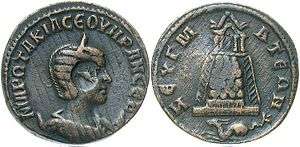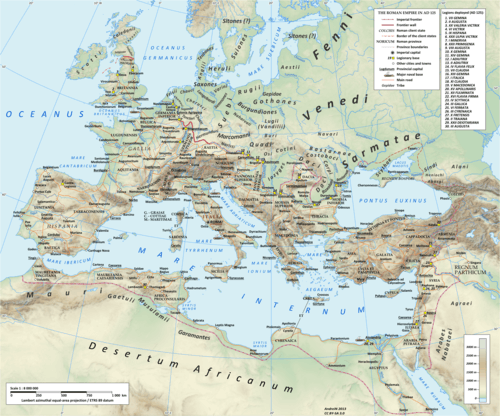Legio IV Scythica
Legio quarta Scythica ("Scythian Fourth Legion") was a legion of the Imperial Roman army founded c. 42 BC by the general Mark Antony, for his campaign against the Parthian Empire, hence its other cognomen, Parthica. The legion was still active in Syria in the early 5th century.

Origin during the Republic
In its first years, the whereabouts of IV Scythica are uncertain, although it is probable that it took part in Antony's campaign against the Parthians. The name suggests that it fought against the Scythians.
Under the Empire
After the battle of Actium and Antony's suicide, Octavian transferred IV Scythica to the Danube province of Moesia. The legion is reported to have taken part in civilian tasks, such as the building and keeping of roads. In his youth, future emperor Vespasian served in this legion.
Roman–Parthian War of 58–63
King Vologases I of Parthia invaded Armenia, a client kingdom of Rome, in 58, beginning the Roman–Parthian War of 58–63. Nero ordered Gnaeus Domitius Corbulo, the new legate of Cappadocia, to manage the matter. Corbulo brought IIII Scythica from Moesia, and with III Gallica and VI Ferrata defeated the Parthians, restoring Tigranes VI on Armenian throne. In 62, IIII Scythica and XII Fulminata, commanded by the new legate of Cappadocia, Lucius Caesennius Paetus, were defeated by the Parthians at the Battle of Rhandeia and forced to surrender. The legions were covered with shame and removed from the war theatre to Zeugma. This city would be the base camp of IIII Scythica for the next century.
Year of the Four Emperors
In the Year of the Four Emperors, in 69, the legion, like the rest of the Eastern army, sided with Vespasian immediately. Despite the demonstrated loyalty, IV Scythica was not involved in actual fighting because it was not considered a high quality legion. This has to do with another defeat years earlier in the Jewish rebellion.
Roman–Parthian War of 161–166
The legion took part in the war against the Parthians between 161 and 166. Between AD 181 and 183 Septimius Severus acted as the commander of the Eastern legions, and he later relied on the power of said legions to become emperor.
Septimius Parthian Campaign
The Legion's former commander, now Emperor, led another campaign against the Parthians.
Revolt and disappearance
The legion disappears from the sources after AD219, when their commander, Gellius Maximus, rebelled against Emperor Elagabalus and proclaimed himself emperor, but was defeated by Elagabalus.
However, according to Notitia Dignitatum (XXXIII), in the early 5th century, IIII Scythica was still in Syria, camped in Orese.
Attested members
| Name | Rank | Time frame | Province | Source |
|---|---|---|---|---|
| Lucius Funisulanus Vettonianus | legatus | c. 62 | Syria | CIL III, 4013, Tacitus, Annales. XV, 7 |
| Gnaeus Pompeius Collega | legatus | 69-c. 70 | Syria | Josephus, Bell. Jud. VII 3, 4 |
| Tiberius Julius Celsus Polemaeanus | legatus | c. 80-82 | Syria | AE 1905, 120, AE 1905, 121 |
| Aulus Larcius Priscus[1] | legatus | c. 97 | Syria | CIL VIII, 17891, AE 1908, 237 |
| Gaius Julius Severus | legatus | c. 132 | Syria | CIG 4031, 4032 = IGR III 173, 174 |
| Gaius Julius Scapula | legatus | c. 135 | Syria | CIG 4022, 4023 |
| Quintus Voconius Saxa Fidus[2] | legatus | ?138-?141 | Syria | IGR III 173, 174 |
| Publius Cornelius Dexter[2] | legatus | ?144-?147 | Syria | CIL III, 12116 |
| Lucius Septimius Severus[3] | legatus | c. 181 - c. 183 | Syria | Historia Augusta, "Vita Severi" 3.6 |
| Aulus Vicirius A.f. Proculus[4] | tribunus laticlavius | c. 50 | Syria | |
| Quintus Paesidius Macedo | tribunus angusticlavius | between 40 and 54 | Syria | AE 1923, 40 |
| Lucius Julius Marinus Caecilius Simplex | tribunus laticlavius | c. 80 | Syria | CIL IX, 4965 |
| Gaius Julius Proculus | tribunus laticlavius | c. 100 | Syria | CIL X, 6658 |
| Publius Manilius Vopiscus Vicinillianus | tribunus laticlavius | c. 107 | Syria | CIL XIV, 4242 |
| Claudius Maximus | tribunus laticlavius | c. 115 | Syria | CIL III, 10336 |
| Tiberius Claudius Helius Secundus | tribunus angusticlavius | between 96 and 118 | Syria | AE 1925, 44 |
| Gnaeus Cornelius Pulcher | tribunus angusticlavius | between 96 and 118 | Syria | IG 4.795 |
| Tiberius Claudius Pius | tribunus angusticlavius | between 100 and 120 | Syria | AE 1933, 270 |
| T. Statilius [...]nus | tribunus angusticlavius | between 118 and 130 | Syria | |
| Gaius Arrius Antoninus | tribunus laticlavius | c. 150 | Syria | CIL VIII, 7030 |
| Gaius Sempronius Fidus | tribunus angusticlavius | between 70 and 150 | Syria | CIL II, 4245 |
| Publius Julius Geminius Marcianus[5] | tribunus laticlavius | c. 155 | Syria | |
| Julius Antoninus | tribunus angusticlavius | between 118 and 161 | Syria | IGR 3.500 |
| Lucius Egnatuleius Sabinus | tribunus angusticlavius | c. 175 | Syria | CIL VIII, 10500 = ILS 1409 |
| Tiberius Claudius Telemachus | tribunus angusticlavius | after 185 | Syria | AE 1981, 844 |
| Lucius Marius Perpetuus | tribunus laticlavius | late 2nd century | Syria | |
| Gellius Maximus[3] | tribunus laticlavius | c. 219 | Syria | Dio Cassius LXXIX 7, 1 |
| Gaius Aemilius Berenicianus Maximus | tribunus laticlavius | first quarter 3rd century | Syria | CIL XII, 3163 |
Epigraphic inscriptions
- - Caio Sempronio Marci filio Galeria (tribu) Fido Calagorritano / tribuno militum legionis IIII Scythicae tribuno militum (...). Tarragona (Tarraco), Spain. CIL II 4427 .
- - D(is) M(anibus) / Ael(ius) Verecundinus |(centurio) leg(ionis) IIII / Scy(thicae) hastatus (p)rior natus / in Dacia ad Vatabos mil(itavit) ann(os) XXI / primum exactus librarius / frum(entarius) speculator evocatus |(centurio) et |(centurio) frum(entarius) / vixit ann(os) XXXVI Ael(ius) Rufinus lib(ertus) ex bon/is eius fecit. Epigraphic Database Heidelberg HD053009.
In popular culture
The Legion appeared in Harry Sidebottom's historical fiction series Warrior Of Rome.
References
- This was a brevet promotion, as quaestors normally lacked the seniority to command a legion.
- Géza Alföldy, Konsulat und Senatorenstand unter der Antoninen (Bonn: Rudolf Habelt Verlag, 1977), p. 298
- Paul M. M. Leunissen, Konsuln und Konsulare in der Zeit von Commodus bis Severus Alexander (Amsterdam: J.C. Gieben, 1989), p. 339
- Vincenzo Saladino, "Iscrizioni Latine di Roselle (II)", Zeitschrift für Papyrologie und Epigraphik, 39 (1980), pp. 229-232
- Dabrowa, Legio X Fretensis: A Prosopographical Study of its Officers (I-III c. A.D.) (Stuttgart: Franz Steiner, 1993), p. 60
- Legions and Veterans: Roman Army Papers 1971–2000 By L. J. F. Keppie page 128

